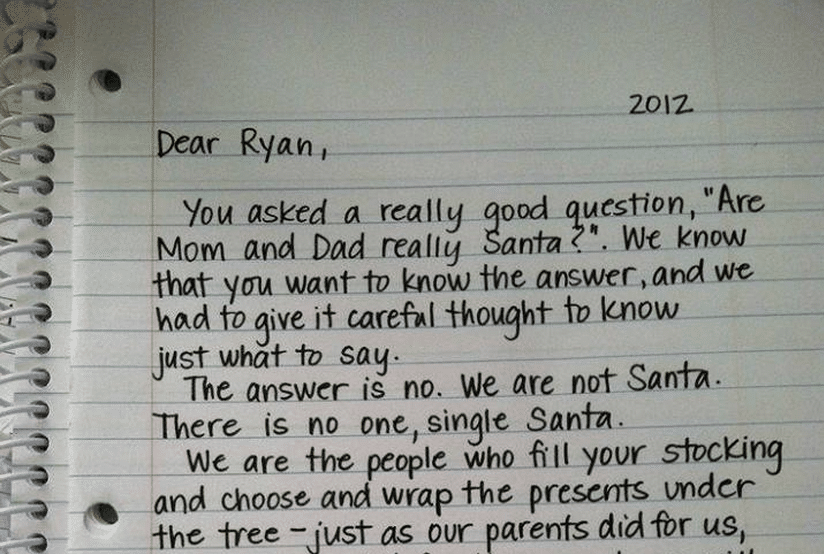There comes a time in every parent’s life where they have to have the dreaded “talk”.
Before the birds and the bees comes the Santa talk.
A child will only believe in the jolly, pot-bellied, man for so long before their clever little brains start to see the impossibility of squeezing down every single chimney in the world within the ridiculously short timeframe.
How to Explain Santa to Kids
It’s a difficult subject to approach because you don’t want your children to think you’ve just been lying to them all this time; you want them to understand why you allowed them to believe in Santa in the first place.
Letter Source Martha Brockenbrough
Martha Brockenbrough has blessed us with a beautiful letter that she wrote to her daughter in 2009 regarding the truth behind the North Pole-dwelling gift giver.
Her daughter, Lucy, wrote a note—all in capitals for emphasis of course—reading, “I NEED TO KNOW, ARE YOU SANTA? TELL ME THE TRUTH.”
As an author of both adult and children’s books, Brockenbrough’s talents really shine through in this incredibly moving letter that offers her daughter an explanation without shattering the magic of Christmas.
Brockenbrough’s letter truly did inspire some as we have found another letter to “Ryan” doing the rounds on the Internet. The unknown authors of this letter have tweaked the above version a little; nevertheless, it’s still beautiful!
When Jo Walsh’s daughter was eight years old, she started questioning the existence of Santa.
Walsh remembered when she learnt the truth at age nine: she was angry at her mother and older sister for keeping that from her, and at the same time, she felt robbed.
Not wanting her own daughter to have the same negative experience, Walsh took inspiration from the letter above to craft her own explanation.
Jonathan Ryan Vassallo wrote a short story, Daddy, Is Santa Claus Real? , which consists mainly of a dialogue between a father and a son a few days before Christmas.
Although the father character, Mr. Bell, never really answered his son’s question, he got him to think and make his own decision on whether or not he wants to believe, and just what it means to believe.












Bob
He is real.
Bob
I know
Anonymous
I hope so
Barbara Eylers
The letters are beautiful. I am coping them to give to my grandson and his wife so they can explain to their children about Santa someday. thanks so much
Debbie
How can I e-mail these letters?
Rosemary
Saint Nicolas was a real person. These say not. search
This article is about the fourth-century Christian saint. For the gift-bearing figure in modern folklore and popular culture, see Santa Claus. For other uses, see Saint Nicholas (disambiguation).
Saint Nicholas
Jaroslav Čermák (1831 - 1878) - Sv. Mikuláš.jpg
Full-length icon of Saint Nicholas by Jaroslav Čermák, showing him with a halo, dressed in clerical garb, and holding a book of the scriptures in his left hand while making the hand gesture for the sign of the cross with his right.
Defender of Orthodoxy, Wonderworker, Holy Hierarch, Bishop of Myra
Born
Traditionally 15 March 270[1]
Patara, Roman Empire
Died
Traditionally 6 December 343 (aged 73)
Myra, Roman Empire
Venerated in
Anglicanism, Baptist, Catholicism, Eastern Orthodoxy, Oriental Orthodoxy, Lutheranism, Methodism, Reformed
Major shrine
Basilica di San Nicola, Bari, Italy
Feast
5/6 December in Western Christianity; 19 December in Eastern Christianity (main feast day – Saint Nicholas Day)
22 May [O.S. 9 May] (translation of relics)[2]
Attributes
Vested as a Bishop. In Eastern Christianity, wearing an omophorion and holding a Gospel Book. Sometimes shown with Jesus Christ over one shoulder, holding a Gospel Book, and with the Theotokos over the other shoulder, holding an omophorion
Patronage
Children, coopers, sailors, fishermen, merchants, broadcasters, the falsely accused, repentant thieves, brewers, pharmacists, archers, pawnbrokers, Aberdeen, Galway, Russia, Greece, Hellenic Navy, Liverpool, Bari, Siggiewi, Moscow, Amsterdam, Lorraine and Duchy of Lorraine
Saint Nicholas of Myra[a] (traditionally 15 March 270 – 6 December 343),[3][4][b] also known as Nicholas of Bari, was an early Christian bishop of the ancient Greek city of Myra in Asia Minor (modern-day Demre, Turkey) during the time of the Roman Empire.[7] He is revered by many Christians as a saint.[8] Because of the many miracles attributed to his intercession, he is also known as Nicholas the Wonderworker.[c] Saint Nicholas is the patron saint of sailors, merchants, archers, repentant thieves, children, brewers, pawnbrokers, and students in various cities and countries around Europe. His reputation evolved among the faithful, as was common for early Christian saints, and his legendary habit of secret gift-giving gave rise to the traditional model of Santa Claus ("Saint Nick") through Sinterklaas.
Ann
Obviously not referring to this Saint Nick but the modern day Santa. Don’t be a grumpy pants and ruin it for the rest of us that are trying to gently break the news for our kids.